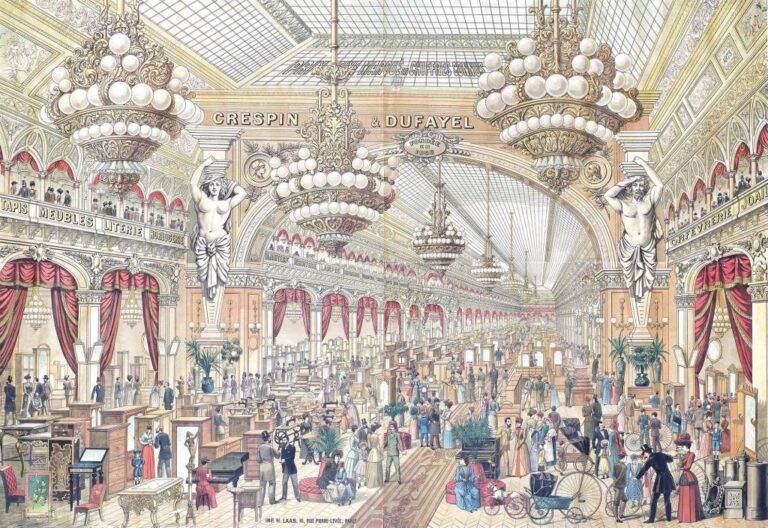Paris — Modernity and marketing coalesced in the rise of Parisian department stores and as the French capital transformed its architecture during the Second Empire.
As small streets gave way to boulevards and Haussmannian buildings, shopping became a new religion practiced in the city's temples of consumption.
A new exhibition at the Musée des Arts Décoratifs in Paris, The Birth of the Department Store, examines this trajectory, the democratization of fashion and modern marketing.
The exhibition features suits and dresses, photographs, posters and advertising business cards, as well as archival footage of the first modeling and fashion presentations. Approximately 80% of the exhibits are sourced from the museum's own collection.
In addition to dresses, hats, and lingerie, advertising works and catalogs are also on display. Department stores also gave rise to the idea of interior decoration as a type of style to be imitated, so some rooms are filled with children's toys, furniture and wallpaper.
“These are works that we have rarely exhibited before, not only in the fashion department, the toy department, the advertising department, including the posters themselves, but also in terms of furniture,” said MAD chief curator Amélie Gastaut.

Galeries Lafayette advertising poster.
Christophe Derriere
Napoleon III was key to this transition, aiming to modernize Paris and destroying the city's maze of alleyways to create the boulevards we know today. According to Gastaut, he wanted to remodel the city in the style of London, where he lived in exile.
“Department stores therefore became a reflection of this modernity, both from an architectural point of view but also in terms of commercial modernity. This was because they were establishing a new commercial system that was the basis of modern marketing.''
Colorful sketches and printed advertising posters depicting beautiful dresses, such as women strolling on the beach under parasols in their finest attire, an inherently aspirational lifestyle, were key to conveying this message of consumption. Ta.
“The idea of a department store is that the purchase should come from desire, not need,” she says. The department store also created a career in display window decoration, direction, and styling. “The entire technical system of a department store is based on the idea that the customer is not just a customer, but first and foremost a visitor who feels desire and creates a consumer culture.”
Through these advertisements, department stores capitalized on the rise of the middle class, first by turning shopping into a leisure activity on a par with going to the theater, and later by selling vacation packages and creating tourism. After that, stores began publishing annual catalogs to promote their products. Catalogs soon became seasonal, with more pages, richer product illustrations, and categories such as fashion, decoration, and homewares.
Department store branded clothing was mass-produced and designed to move quickly, following trends and stores began offering complete ready-to-wear clothing.

One of the first catalogs on display.
Women also gained new freedom at department stores, as they offered not only shopping but also safety.
“Department stores were pretty much the only place. [women] I was 'cleared' to go in complete safety,” Gastaut said. For the middle class, who had previously received visitors in their living rooms, it became a more casual third space.
“It's a place where you can spend all day as a place for women's leisure. It's free to enter, you can eat and drink, and there are exhibits, so it was a place where you could spend all day,” she said.
“It's liberating in a way, both for the customers and for the department store salespeople. The majority were from the rural lower middle class and were coming up. [to Paris and] Being a salesperson in a department store already meant upward mobility–maybe not upward mobility, but it offered the possibility of independence. ”
The exhibit also delves into these workers. Although most departments were dominated by men, women also had employment opportunities in department stores. Employees were able to receive food, housing, and medical care through each department store, creating a system of dependence. But it was short-lived for employees. Most employees retired at the age of 35 and returned to their native city.
Their lives were the inspiration for Émile Zola's Ladies' Delights. He interviewed many employees of his Louvre Museum for his 1883 novel Aubon Marché and Grand Magasin du.

Silk faille and taffeta dresses of the time.
Today's fashion is still focused on the idea of “French girl style'', but here are its origins. Advertisements promoted the idea of ”La Parisienne” and taught women how to be elegant and have good taste through fashion.
The stores also captured the idea that women were the main consumers and appealed to them by idealizing children, such as by setting up toy departments and focusing on child-rearing. “They had already created the idea that women were the best selling tool,” Gastaut added.
“The Birth of a Department Store” is on until October 13th.


